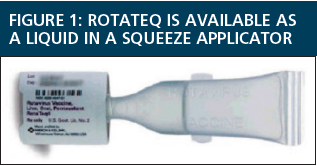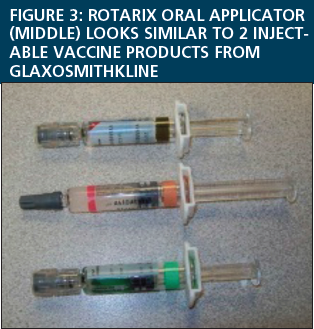Oral Vaccine Mistakenly Given by Injection

To protect children against rotavirus gastroenteritis, 2 oral live rotavirus vaccines are available in the United States. These rotavirus vaccines have been the only oral vaccines given to children in the United States since the use of live oral poliovirus vaccine was discontinued in 2000. Therefore, providers now have less experience administering oral vaccines. On occasion, providers have accidentally injected oral rotavirus vaccine, making it ineffective.
The Centers for Disease Control and Prevention (CDC) examined reports of accidental injection submitted from January 1, 2006, to August 1, 2013, to the Vaccine Adverse Event Reporting System (VAERS), which is operated jointly by the CDC and the FDA.1 There were 39 reports of accidental injection of the oral vaccine. ROTATEQ, a Merck product available as a liquid in a squeeze applicator (Figure 1), was involved in 6 of the errors. Most cases (33 of 39) happened with the GlaxoSmithKline (GSK) product ROTARIX, which requires reconstitution. This product comes with a prefilled oral applicator syringe that holds the diluent for reconstitution of the lyophilized vaccine vial (Figure 2). The reconstituted liquid vaccine is then supposed to be drawn back into the oral applicator via the transfer device and administered orally.


Errors have happened when the Rotarix vaccine vial was thought to be a vial of injectable medicine, the Rotarix oral applicator syringe was thought to be a parenteral syringe (Figure 3 illustrates the similarity between the Rotarix oral applicator and 2 injectable vaccine products), staff had been inadequately trained, or the package insert was difficult to read or was not reviewed. The Institute for Safe Medication Practices (ISMP) has also learned from other sources that the oral applicator, which does not properly connect to a needle, has been rigged by taping a needle to the syringe tip. In a case involving the GSK product reported to the ISMP National Vaccine Errors Reporting Program (VERP), the facility stored the transfer devices and the oral applicator syringes separately from the vaccine vials, which were kept in a refrigerator, along with other vaccines. The nurse was unaware that the necessary transfer devices and oral applicators were in a cabinet several feet away from the refrigerator. The nurse assumed that all vaccines were given by injection, and she chose the intramuscular route without checking the label.
Interestingly, the Rotarix product is available outside the United States, including in Canada, as a ready-to-use liquid, so it is not clear why it is not available in this form in the United States. The CDC and ISMP have brought this type of error to the attention of vaccine manufacturers and the FDA. Pharmacies that supply physician office practices or clinics with this vaccine, and all ambulatory practices, should be sure to make their staff aware of this potential problem.
Dr. Gaunt is a medication safety analyst and the editor of ISMP Medication Safety Alert! Community/ Ambulatory Care Edition.
Reference
1. Hibbs BF, Miller ER, Shimabukuro T. Notes from the field: rotavirus vaccine administration errors—United States, 2006—2013. MMWR. 2014;63(04):81.

